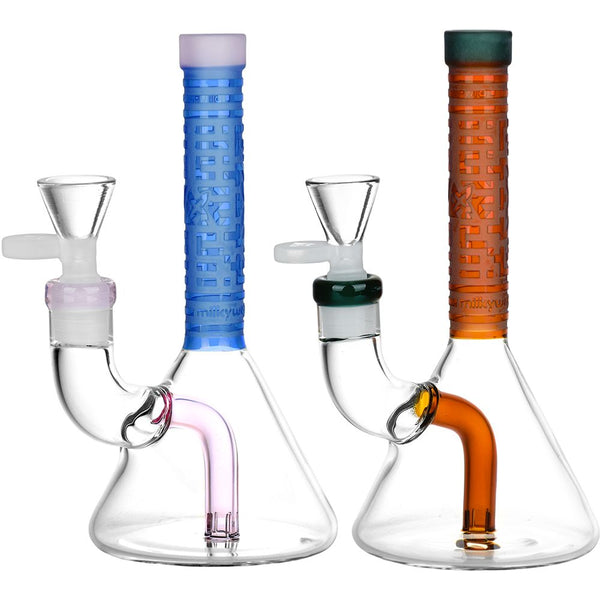What is Bong Water? Why It's Important For a Smooth Smoking Experience

Ever wondered why your bong needs water? Bong water cools down smoke, making it smoother to inhale. This post will guide you through using bong water correctly, from filling it up to keeping it clean.
Stick around for some eye-opening facts!
Key Takeaways
- Bong water cools and filters smoke, giving you a smoother inhale. It catches bad bits like tar from the smoke.
- You need to pick the right amount of water for your bong. Too little or too much can mess up how well it works.
- Types of percolators in bongs, such as tree or honeycomb, help make the smoke even cleaner by filtering it more.
- Keeping your bong clean is super important. Dirty bong water can make you sick because of germs and mold.
- Changing the water after every use keeps your smoking experience nice and healthy. Always clean your bong well to avoid risks.
What is Bong Water and Why Do Bongs Need it?
Bong water is a crucial component of a bong as it helps in cooling and filtering the smoke to provide a smoother smoking experience. Different types of percolators further enhance the filtration process by diffusing the smoke through water, making it an essential part of using a bong.
Cooling and filtering smoke
Bong water plays a key role in making your smoking experience smoother. It cools down the smoke before it hits your lungs. This makes inhaling easier and less harsh on your throat.
The water also traps some of the heavier particles that come from burning herbs. These particles include tar and toxic substances, keeping them out of your body.
The process isn't just about cooling; it's also about cleaning the smoke. As you take a hit, the smoke passes through the water, leaving behind unwanted bits. This means each puff is cleaner and tastes better.
Many smokers prefer using bongs for this reason—they get to enjoy purer smoke with every session.
Components of a bong
A bong consists of a bowl, downstem, and base. The bowl holds the substance to be smoked, while the downstem is a tube that directs the smoke into the water. The base holds the water, which cools and filters the smoke.
Different types of percolators can also be part of a bong. These include tree percolators and honeycomb percolators, designed to further filter and cool the smoke as it passes through them.
Different types of percolators
Percolators come in various types, such as tree, honeycomb, and showerhead percs. Each type offers different filtration and cooling benefits to enhance your smoking experience. Tree percolators feature multiple arms that diffuse the smoke for a smoother hit.
Honeycomb percolators contain multiple holes to break up the smoke and increase water contact for efficient filtration. Showerhead percs have a wide surface area that cools the smoke as it passes through.
Experimenting with these different types can help you find the perfect hit for your preferred smoking style.
Different types of percolators, like tree, honeycomb, and showerhead varieties are available to enhance your smoking experience with varying filtration and cooling benefits tailored towards your preferences.
How to Properly Fill a Bong with Water
Fill your bong with water up to the optimal level for its style. Adjust for percolators and ice catchers, understanding the science behind water filtration.
Optimal water levels for different bong styles
For a basic bong, the water level should cover the bottom opening of the stem.
In a beaker bong, the water level should be higher to cover the downstem without overflowing into it.
In a straight tube bong, fill with enough water to submerge the bottom of the downstem by about an inch.
Adjusting for percolators and ice catchers
When adjusting for percolators and ice catchers:
- Ensure the water level covers the percolator's openings, optimizing smoke filtration.
- Add enough water to cover the ice catcher without overflowing, enabling smooth smoke cooling.
- Consider the percolator type – tree, honeycomb, or inline – and adjust water height accordingly to maximize filtration effectiveness.
- Place ice cubes in the catcher, but ensure they don't displace too much water and impede suction.
- Test draw resistance and adjust water levels as needed for a personalized smoking experience.
The science behind bong water filtration
Bong water acts as a filtration system that cools and cleans the smoke. When you inhale, the smoke passes through the water, which removes some of the harmful substances like tar before reaching your lungs.
The water also helps to cool down the hot smoke, making it smoother for inhalation. As a result, bong water plays a crucial role in filtering out impurities and providing a more enjoyable smoking experience.
A percolator bong enhances this process by increasing the surface area of the smoke that comes into contact with the water. This means more toxins are filtered out as they pass through multiple chambers within the bong.
Debunking Myths and Misconceptions About Bong Water
Debunking myths and misconceptions about bong water is essential for understanding its role in smoking devices. Read more to discover the truth.
Addressing concerns about cleanliness
Concerns about cleanliness surrounding bong water are valid. Residues from cannabis, tobacco, or other herbal substances can accumulate in the water and can lead to bacterial or mold growth if not cleaned regularly.
Dirty bong water may also expose you to potential health risks when particles from the water are inhaled along with the smoke. Ensuring that you clean your bong and change the water after every use is crucial to avoid these risks.
Ensuring that your bong stays clean isn't just for aesthetics - it's a matter of ensuring your health and safety as well as optimizing your smoking experience. Regular cleaning will prevent buildup in the water, reducing any potential harm caused by inhaling dirty residues.
Bong water as a toxin trap
Bong water can trap toxins from the smoke, including harmful compounds like tar and ash. When you use a bong for smoking weed or tobacco, the water works to filter out some of these impurities, preventing them from reaching your lungs.
This filtration helps reduce the amount of potentially harmful substances you inhale. However, it's essential to clean your bong regularly because dirty bong water can become a breeding ground for bacteria and mold, posing potential health risks if inadvertently consumed or inhaled.
So remember to change your bong water frequently and clean your device meticulously to avoid any health concerns related to using a contaminated filtration system.
The Importance of Cleaning Your Bong
Cleaning your bong is crucial for maintaining your health and enjoying a smooth smoking experience. For more information, read the full blog on our website.
Risks and considerations for smoking weed
Smoking weed can lead to respiratory issues like coughing and wheezing due to inhaling hot smoke. It can also cause lung irritation and an increased risk of chronic bronchitis.
Long-term use may impair short-term memory and affect learning abilities, especially in young users. Additionally, smoking cannabis can increase heart rate which may pose risks for individuals with existing heart conditions or high blood pressure.
Considering the potential health risks associated with smoking weed, it's important for users to be aware of these factors and make informed choices about their consumption habits.
How to clean a bubbler
To clean a bubbler, you will need:
- Isopropyl alcohol and coarse salt.
- Disassemble the bubbler, then rinse with warm water.
- Fill the chamber and mouthpiece with isopropyl alcohol.
- Add salt to the chamber and shake well for a few minutes.
- Let it sit for 30 minutes or more.
- Rinse thoroughly with warm water until all residue is gone.
- Use a pipe cleaner for any stubborn spots.
Remember that cleaning your bubbler regularly maintains its functionality and prevents buildup of harmful residues. Keep it clean for a smooth smoking experience.
Potential health risks of drinking dirty bong water
Dirty bong water poses serious health risks. Bacteria and mold thrive in stagnant water, making it a breeding ground for harmful microorganisms that can cause lung infections and other respiratory issues when inhaled.
In addition, accidentally ingesting dirty bong water can lead to severe gastrointestinal problems, including nausea, vomiting, and diarrhea.
To avoid these health hazards, prioritize keeping your bong water clean at all times. Regularly change the water after each use and thoroughly clean the bong to prevent the accumulation of harmful substances.
Conclusion: The Role and Necessity of Water in Bong Functionality
Water in bongs cools and filters smoke, making it healthier. Proper water levels vary by bong style and percolators. Clean your bong regularly to avoid health risks.
FAQs
1. What is bong water?
Bong water is the water used in a water pipe, also known as a bong, which acts as a filtration device for smoking substances like cannabis or tobacco.
2. How does bong water work?
When you smoke through a bong, the smoke passes through the bong water before you inhale it. This helps filter out tar and cool down the smoke, making it smoother to inhale.
3. Can anything be added to bong water to improve its filtering ability?
Yes, some people add substances like potassium permanganate to their bong water to further help in filtering out impurities from the smoke.
4. Is there a difference between using bong water for smoking tobacco versus marijuana?
While both tobacco and marijuana can be smoked using a bong with water, the main difference lies in what's being filtered, THC from marijuana and nicotine along with other components from tobacco.
5. Should I change my bong water after use?
Yes! It's important to change your bong water regularly because dirty or stagnant waters can harbor bacteria and affect the taste of your smoke negatively.



























